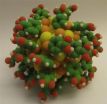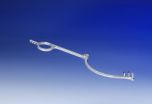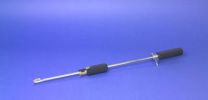Stretched rubber offers simpler method for assembling nanowires
2011-03-01
(Press-News.org) Researchers at North Carolina State University have developed a cheap and easy method for assembling nanowires, controlling their alignment and density. The researchers hope the findings will foster additional research into a range of device applications using nanowires, from nanoelectronics to nanosensors, especially on unconventional substrates such as rubber, plastic and paper.
"Alignment is a critical first step for developing devices that use nanowires," says Dr. Yong Zhu, an assistant professor of mechanical and aerospace engineering at NC State and co-author of a paper describing the research. "Hopefully our simple and cost-effective method will facilitate research in this field."
Aligning nanowires is challenging because, when they are created, the user is faced with a profusion of randomly oriented nanoscale wires that are, by definition, incredibly small. For example, the nanowires are between 10 and 100 nanometers in diameter, whereas a white blood cell is approximately 10,000 nanometers in diameter. Before any practical applications can be pursued, the user must assemble the nanowires in an orderly way. Specifically, users need to align the nanowires in a common direction and define their density – meaning the number of nanowires in a given area. Controlling both alignment and density is commonly called "assembling" the nanowires.
In the new method, Zhu's team deposited the nanowires on a stretched rubber substrate, and then released the tension on the substrate. When the nanowires settled, they aligned at a right angle to where the tension was coming from. Picture a rubber band being stretched to the east and west. If nanowires were placed on the rubber band, and the band was allowed to snap back to its original shape, the nanowires would be oriented to the north and south. The more the rubber substrate is stretched, the more aligned the nanowires will be, and the greater the nanowire density will be.
Previous research has presented a number of other methods for assembling nanowires. But the new method offers a number of distinct advantages. "Our method is cost-effective," says Feng Xu, a Ph.D. student working on this project, "because it is so simple. It can also be used for nanowires synthesized by different methods or processed in different conditions, for instance, silver nanowires synthesized in solution and silicon nanowires synthesized by the vapor-liquid-solid method, as demonstrated in our work." In addition, the new method can be used in conjunction with previous methods to achieve even better nanowire assembly.
The use of a rubber substrate in this method facilitates broad research and manufacturing sectors. For example, a key element of research into stretchable nanoelectronics involves aligning nanowires on a stretchable rubber substrate. Similarly, rubber is also the material used as "stamps" in transfer printing – a critical fabrication method used in manufacturing nanodevices on diverse substrates ranging from silicon to glass to plastic.
Zhu notes that the initial step of the method, when the nanowires are first deposited on stretched rubber, sometimes yields an inconsistent degree of nanowire alignment. The team is currently working to understand the fundamental interface mechanics -including adhesion and static friction -between nanowires and rubber substrates, which is expected to lead to a better control of the assembly process and hence a higher yield of the nanowire assembly.
INFORMATION:
The paper, "Strain-Release Assembly of Nanowires on Stretchable Substrates," was published Feb. 22 in ACS Nano. The paper was co-authored by Zhu, Xu, NC State Ph.D. student John Durham, and Dr. Benjamin Wiley, an assistant professor at Duke University. The research was funded by the National Science Foundation.
END
ELSE PRESS RELEASES FROM THIS DATE:
2011-03-01
Ulysses Balis, M.D., clicks a mouse to identify a helicopter in a satellite photo of Baghdad, Iraq. With another click, an algorithm that he and his team designed picks out three more choppers without highlighting any of the buildings, streets, trees or cars.
Balis isn't playing war games. The director of the Division of Pathology Informatics at the University of Michigan Medical School is demonstrating the extreme flexibility of a software-tool aimed at making the detection of abnormalities in cell and tissue samples faster, more accurate and more consistent.
In a ...
2011-03-01
UPTON, NY - A brain imaging study at the U.S. Department of Energy's (DOE) Brookhaven National Laboratory reveals a subtle difference between ordinary obese subjects and those who compulsively overeat, or binge: In binge eaters but not ordinary obese subjects, the mere sight or smell of favorite foods triggers a spike in dopamine - a brain chemical linked to reward and motivation. The findings - published online on February 24, 2011, in the journal Obesity - suggest that this dopamine spike may play a role in triggering compulsive overeating.
"These results identify dopamine ...
2011-03-01
Nanometre-scale gold particles are currently intensively investigated for possible applications in catalysis, sensing, photonics, biolabelling, drug carriers and molecular electronics. The particles are prepared in a solution from gold salts and their reactive gold cores can be stabilised with various organic ligands. Particularly stable particles can be synthesised by using organothiolate ligands that have a strong chemical interaction to gold. The chemical process of preparing such particles has been known since the mid-1990s and many different stable sizes and compositions ...
2011-03-01
Sexuality and religion are generally considered uncomfortable bedfellows. Now, for the first time, a team of researchers from Nottingham have carried out a detailed study around these issues and how they affect and influence the lives of British 18 to 25 year olds.
Led by The University of Nottingham, in collaboration with Nottingham Trent University, experts spent two years investigating the attitudes, values and experiences of sex and religion among young adults.
The study, which involved nearly 700 young people from six different religious traditions; Buddhism, Christianity, ...
2011-03-01
One in eight Americans will fall prey to Alzheimer's disease at some point in their life, current statistics say. Because Alzheimer's is associated with vascular damage in the brain, many of them will succumb through a painful and potentially fatal stroke.
But researchers led by Dr. Dan Frenkel of Tel Aviv University's Department of Neurobiology at the George S. Wise Faculty of Life Sciences are working on a nasally-delivered 2-in-1 vaccine that promises to protect against both Alzheimer's and stroke. The new vaccine repairs vascular damage in the brain by rounding up ...
2011-03-01
Ever get a flu shot and still get the flu? If so, there's new hope for flu-free winters in the years to come thanks to a new discovery by researchers who found that a drug called DMXAA, originally developed as anti-tumor agent, enhances the ability of flu vaccines to ward off this deadly virus. A new research report appearing in the March 2011 issue of the Journal of Leukocyte Biology (http://www.jleukbio.org) suggests that DMXAA could assist flu vaccines by causing the body to produce its own antiviral proteins, called interferons, which interfere with the virus's ability ...
2011-03-01
Be it a heart transplant or a Cesarean section, every operation requires a wide variety of surgical instruments, from simple retractors, clamps, scalpels and scissors to more specialist devices such as cerclage wire passers, which surgeons employ to repair long, oblique fractures in bones. These are shaped in such a way as to half encircle the broken bone, and incorporate a hollow channel. In a process not unlike stringing a parcel for posting, thread or wire is fed through the channel around the damaged bone and then knotted in place, both to support the bone and to hold ...
2011-03-01
More and more often, abdominal surgeries are being carried out in a minimally invasive manner. A small incision in the abdominal wall is sufficient for the surgeon to be able to insert the instrument and make the organs visible with an endoscope. This technique is gentler and does not stress the body as much as traditional surgeries do. However, these minimally invasive surgeries pose a special challenge to the surgeons. In particular, the suturing – meaning joining the tissue with needle and suture material - demands great skill and dexterity. Very often, piercing the ...
2011-03-01
Part of the answer to how and why primates differ from other mammals, and humans differ from other primates, may lie in the repetitive stretches of the genome that were once considered "junk."
A new study by researchers at the University of Iowa Carver College of Medicine finds that when a particular type of repetitive DNA segment, known as an Alu element, is inserted into existing genes, they can alter the rate at which proteins are produced -- a mechanism that could contribute to the evolution of different biological characteristics in different species. The study was ...
2011-03-01
In an interesting bit of scientific serendipity, researchers at North Carolina State University have found that a chemical compound useful for studying the origins of intestinal birth defects may also inhibit the growth and spread of cancerous tumors.
During the screening of chemical compounds created by NC State chemist Dr. Alex Deiters, developmental biologist Dr. Nanette Nascone-Yoder found one of particular interest to her research: a compound that induced heterotaxia, a disordering or mirror-image "flipping" of internal organs, in the frog embryos she was studying. ...
LAST 30 PRESS RELEASES:
[Press-News.org] Stretched rubber offers simpler method for assembling nanowires


